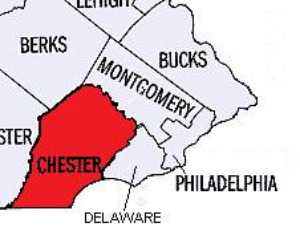Related Topics
Particular Sights to See:Center City
Taxi drivers tell tourists that Center City is a "shining city on a hill". During the Industrial Era, the city almost urbanized out to the county line, and then retreated. Right now, the urban center is surrounded by a semi-deserted ring of former factories.
Sights to See: The Outer Ring
There are many interesting places to visit in the exurban ring beyond Philadelphia, linked to the city by history rather than commerce.
Gardens Flowers and Horticulture
Gardening, flowers and the Flower Show are central to the social fabric of Philadelphia.
Chester County, Pennsylvania
 Chester was an original county of Pennsylvania, one of the largest until Dauphin, Lancaster and Delaware counties were split off. Because the boundaries mainly did not follow rivers or other natural dividers, translating verbal boundaries into actual lines was highly contentious.
Chester was an original county of Pennsylvania, one of the largest until Dauphin, Lancaster and Delaware counties were split off. Because the boundaries mainly did not follow rivers or other natural dividers, translating verbal boundaries into actual lines was highly contentious.
Gardens for Posterity

|
| J. B. Garden |
We must be indebted to "Several Anonymous Philadelphians" who wrote a book published in 1956 called Philadelphia Scrapple, now out of print but subtitled "Whimsical Bits Anent Eccentricities and the City's Oddities." The Athenaeum librarian has carefully penciled in the names of Harold Donaldson Eberlein and Mrs. Henry Cadwalader as the probable authors of this work, and it's likely that is the fact of it.
Chapter XIV of "Philadelphia Scrapple" discusses a class of notable public gardens not designed to be show gardens, but originally the hobbies or passions of the original owner for private enjoyment, and later were opened to the public. These abound in Philadelphia, sometimes somewhat decayed, often truncated as the land was sold off, but constantly increasing in interest as the boxwood, trees, and shrubs continue to grow in size and rarity. The Anonymous Philadelphians have classed these lovely and somewhat unknown places as "Gardens for Posterity". Quite often, the estate houses to which they belong are better known than their gardens, and the original owners just regarded their gardens as a normal part of the house.
While there are dozens of such places, the more notable ones are Grumblethorpe in Germantown, The Grange in Delaware County, Andalusia along the Delaware, and two famous gardens in decrepit neighborhoods along the lower Schuylkill, John Bartram's Gardens and William Hamilton's ("Woodlands"). There is a record that the Continental Congress once adjourned to visit Bartram's garden, and Hamilton's garden is mentioned by several famous Revolutionary figures since it was on what was then the main route from Philadelphia to the Southern Colonies. John Wister's 1744 garden at Grumblethorpe was 188 by 450 feet in size; some of the boxwood have had a long time to grow.

|
| Pennsylvania Hospital |
To these should be added the hospital gardens at the Pennsylvania Hospital, at Friends Hospital along Roosevelt Boulevard, and the garden of Chester-Crozier Hospital, all of which are especially spectacular in early May when the Azaleas are in bloom. Just about every surviving mansion of colonial rich folks had such a garden at one time.
And tucked away behind many current mansions are lovely gardens that are considered to be just as private as their living rooms. While they are proudly displayed to friends, strangers knocking at the garden door would be considered the height of rudeness. It will take another generation or so for them to be thrown open to the public. By that time, who knows what state of repair they will be in.
For a unified access point for 30 gardens in the Philadelphia area, try www.greaterphiladelphiagardens.org
Originally published: Monday, June 26, 2006; most-recently modified: Monday, May 20, 2019